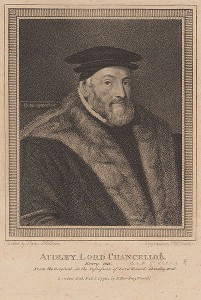 On 24th April 1536, Sir Thomas Audley, Henry VIII’s Lord Chancellor and Thomas Cromwell’s right hand man, set up two commissions of oyer and terminer at Westminster.
On 24th April 1536, Sir Thomas Audley, Henry VIII’s Lord Chancellor and Thomas Cromwell’s right hand man, set up two commissions of oyer and terminer at Westminster.
‘Oyer and terminer’ comes from the French ‘to hear and to determine’ and denotes a legal commission formed to investigate and prosecute serious criminal offences, such as treason, committed in a particular county. A grand jury in the county would first investigate the alleged offence and then approve a bill of indictment, if there was sufficient evidence. The case would then go on to the commission of oyer and terminer, the court with jurisdiction to try the offence(s).1
The two commissions of oyer and terminer set up by Audley were for offences committed in the counties of Middlesex and Kent and covered the crimes of misprision, treason, rebellion, felonies, murder, homicide, rioting, plotting, insurrection, extortion, oppression, contempt, concealment, ignorance, negligence, falsities, deception, conspiracy and being an accessory to these crimes.2 The job of the commission was to investigate alleged crimes and to determine if there was indeed a case. These commissions were not common-place; in fact, there were only seventeen set up during the whole of Henry VIII’s reign.3 The fact that these commissions were so rare, combined with the fact that they were set up to judge offences in the counties of Middlesex and Kent – the counties of the grand juries which would later investigate the alleged offences of Anne Boleyn – suggest that the plot against Anne Boleyn was well underway at this time. These commissions surely could not have been a coincidence.4
Historian Eric Ives5 notes that Henry VIII’s signature was not on the patent of the oyer and terminer. This may suggest that the commissions were ordered not by the King, but by Thomas Cromwell and Thomas Audley. Both Ives and Alison Weir explain how these commissions were usually only ordered after an arrest. For example, in the case of Sir Thomas More, an oyer was only issued after he had been interrogated for eight weeks. Nobody had been arrested for treason in April 1536, so why the commissions? Could it be that Cromwell and Audley wanted to move quickly before the King could change his mind? Before Anne could talk him round?
Did the setting up of these commissions signal the end for Anne Boleyn? Was this event “virtually a death warrant for Anne”?6 I believe so. I think it is too much of a coincidence; these commissions in 1536 were certainly only used in the case of the coup against the Boleyns. No other case of treason was investigated at this time. However, G W Bernard7 believes that Henry VIII was fully committed to Anne Boleyn right up until her arrest and that the commissions need not have been set up to deal with Anne. He notes that as late as 25th April Henry VIII was sending instructions to Richard Pate, his ambassador in Rome, regarding his divorce from Catherine of Aragon. But was Henry just keeping up appearances or were Cromwell and Audley acting alone at this point? It’s impossible to know, but something was amiss.
(Extract taken from The Fall of Anne Boleyn: A Countdown by Claire Ridgway, p57-58)
Click here for an interactive timeline of the fall of Anne Boleyn in April/May 1536.
Notes and Sources
- Ives, Eric (2004) The Life and Death of Anne Boleyn, Blackwell Publishing, p322
- Encyclopædia Britannica. Eleventh Edition. (1911), Cambridge University Press
- Wriothesley, Charles (1875) A Chronicle of England During the Reigns of the Tudors, from A.D. 1485 to 1559, Camden Society, p190, Baga de Secretis Pouch VIII
- Weir, Alison (2009) The Lady in the Tower: The Fall of Anne Boleyn, Jonathan Cape, p89.
- Ibid.
- Friedmann, Paul (2010) Anne Boleyn, Amberley, p228
- Bernard, G W (2011) Anne Boleyn: Fatal Attractions, Yale University Press, p134